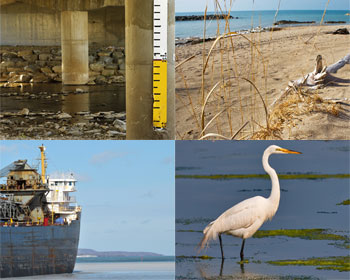A Publication of the
Applied Math and Science Education Repository

The AMSER Science Reader Monthly aims to provide educators with a useful package of information about a particular topic related to applied math and science by combining freely available articles from popular journals with curriculum, learning objects, and web sites from the AMSER portal. The AMSER Science Reader Monthly is free to use in the classroom and educators are encouraged to contact AMSER with suggestions for upcoming issues or comments and concerns at [email protected].
This month's AMSER Science Reader Monthly topic is Lake Ecology.
Down the Drain: The Incredible Shrinking Great Lakes
Article
by John G. Mitchell for National Geographic magazine
Synopsis and resource annotations by Max Grinnell

The Great Lakes continue to face a number of severe challenges, including the invasion of zebra mussels, global warming, and the increased demand for water from places like Chicago. In this engaging article from National Geographic magazine, John G. Mitchell takes a look at some of these challenges through interviews with hydrology experts, local residents, and others.
The piece begins with a conversation with Ted Cline, who lives on Lake Michigan's Grand Traverse Bay. Cline talks about the ways in which he has seen the lake change over the past fifty years. Despite recent droughts and higher temperatures creating the lowest lake levels in 40 years, Cline still believes, "Oh, the lake will come back up someday." Mitchell goes on to talk about the basic facts surrounding the Great Lakes system in detail, examining the complex hydrologic cycle and the recent evaporation trends that have affected the water levels and the lives of those who live on and around the Great Lakes.
Mitchell continues the article with a discussion of several organizations that have experienced some positive news in the Great Lakes area. According to Scientist Will Cwikiel of the Tip of the Mitt Watershed Council, "Periodic low water levels are important. Wetlands and exposed bottomlands are among the most biologically productive ecosystems in the Great Lakes." The piece concludes with an overview of some of the plans that have been floated over the past fifty years to transform the Great Lakes, including an idea that would have seen the Great Lakes tapped to reinvigorate the water levels in the Ogallala aquifer under the Great Plains.
Found below is a list of useful resources that will illuminate and enhance understanding of the topics found within this article. The first link will take visitors to the TEACH Great Lakes website. Here visitors will want to use the online lessons which talk about relevant issues, such as hydrology, pollution, and environmental change. The second link takes users to a website provided by the University of Minnesota which covers the basics of the physical, chemical, and biological properties of lakes. Moving on, the third link leads to an excellent website of the film Waterlife, created by the National Film Board of Canada. Visitors can watch the film here, and also learn about the most pressing issues facing the Great Lakes. The fourth link leads to a research paper from the Brookings Institution that takes a critical look at the benefits of restoring the Great Lakes ecosystem. Visitors will also find the fifth website most helpful, as it includes information about the International Association for Great Lakes Research and their scholarly investigations. The final link leads to the homepage of the Great Lakes St. Lawrence Seaway System, which has an interactive "Gateway to North America" tour and a helpful "Facts and Figures" area.




